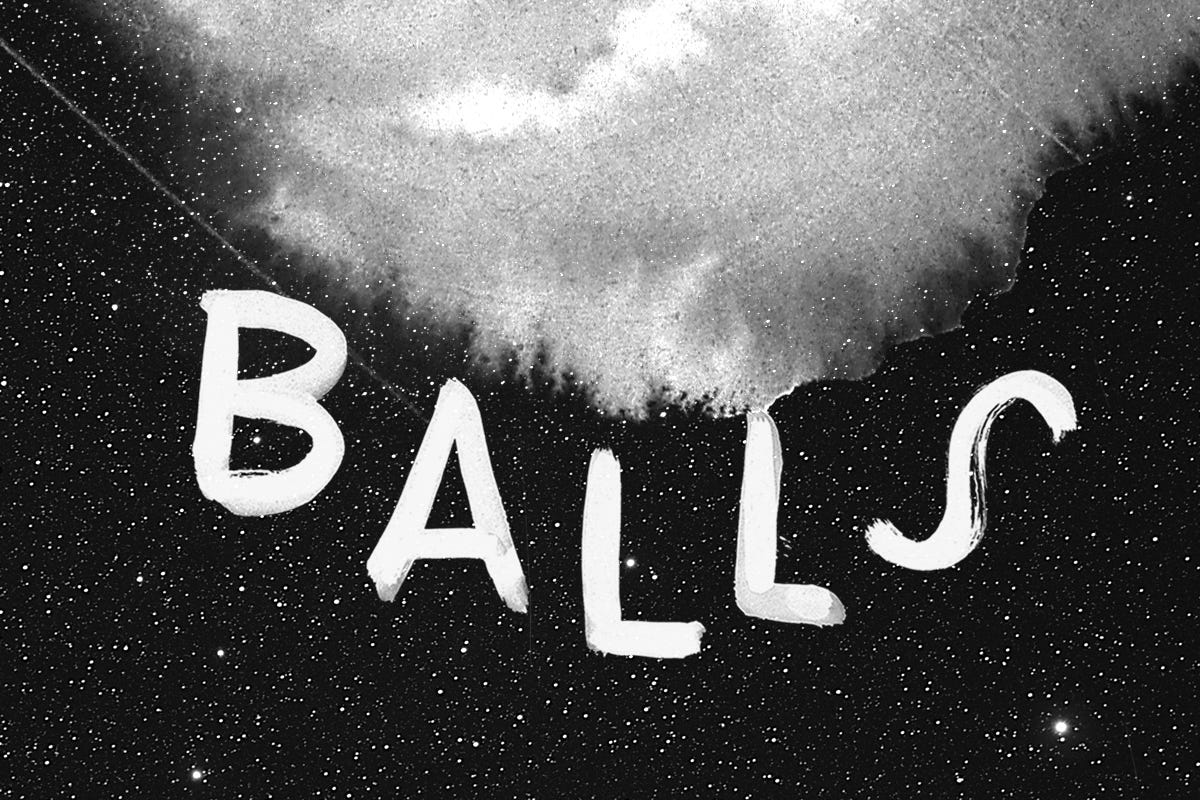
No Proscenium sent NYC correspondents Allie Marotta and Cheyenne Ligon an immersive, multimedia take on Paul Fosters’ 1964 play at CultureHub. Below are their two perspectives.
Cheyenne: Three flights of creaky wooden stairs lead us from a generic building lobby in the Village to CultureHub, the venue where Balls is performed. A woman in a long black dress speaks in hushed tones as she leads us to a completely black room, empty and silent save for two white geodesic domes and the soft sound of crashing waves coming from several speakers scattered around the floor. The show is just for the two of us; we are each led to our own igloo and told to relax on a reclining lawn chair under the dome.
Allie: I move with great care as I enter the room. We are instructed to watch our heads as we each step into our very own dome. The dome is speckled with stars, it feels as if we’re meant to be stargazing in an empty field smack dab in the middle of nowhere. I relax into the chair as an image of two balls appears before my very eyes, one a simple golf ball and the other something unfamiliar entirely, composed of tiny threads interwoven into a sphere. A man’s voice floats into existence, followed by another, and the balls begin their pendulous swing.
Balls by Paul Foster originally premiered at Cafe La MaMa in 1964 and is now reimagined 55 years later in an immersive context by CultureHub and the Great Jones Repertory Company. The production is curated as a part of CultureHub and La MaMa’s initiative to tap into the La MaMa archive and “re-discover” past productions “in a new media context.” Accommodating only two spectators per performance, this contemporary version of Balls seeks to immerse the audience in the tumultuous waters of an unlikely relationship. However, in terms of story, this ship fails to ever really set sail.
Cheyenne: The initial sounds of crashing waves set the stage for the ensuing events. Two souls, apparently unknown to one another in life, are neighbors in the afterlife. Their graves lay side by side, buried on coastland that has slowly begun sinking into the sea. With no one else to talk to but one another, the two souls are well acquainted. They are aware of things happening around them, above their graves, and seem to have as much capacity to remember events in death as they did in life. For example, when a group of school children on a field trip to the beach stops to pee on the grassy area Wilkinson and Beau-Beau are buried under, they reminisce and laugh about how much the teacher leading the field trip peed last year. But Wilkinson’s laugh becomes a wheeze that lasts too long, becoming uncomfortable to listen to, a pattern which Balls seems to follow. When you feel yourself smiling, or think you’re beginning to understand what you’re hearing, the moment is flipped and you are lost again, uncomfortable and alone.
Allie: The text of Balls is performed as a radio play which makes it quite hard to follow. We hear dialogue from the voices of two distinct characters. At times they speak to each other, and at other times into the void. We are in one place, somewhere near the ocean as there is the constant soundscape of crashing waves and they often talk of life at sea, but it’s unclear where. The geodesic dome and the contents projected onto it don’t offer any context either. First covered in the stars of the night sky, it transgresses into a consistent image of two balls, swinging in a pendulum. This image is a direct homage to the original production which featured the same event spotlighted on the stage. The “balls” mean something to the two men, but what exactly that might be is unclear.
Cheyenne: Beau-Beau, who seems to be the younger of the two, is afraid when the balls appear. When he asks why he can suddenly see the balls, Wilkinson tells him, “They’re not balls. They’re an exegesis.” It’s unclear what he means. My confusion was not helped by the fact that I had no idea what an exegesis was. In the moment, I was lost. Later, I learned that an exegesis is a critical interpretation of a text, particularly scripture. But even with a definition, I still had no answers. Who is the critic? What text is being interpreted? And, most importantly, what is the interpretation? Beau-Beau doesn’t ask for clarification and thus we, as the audience, are left to wonder. Wilkinson tells him to close his eyes and try the “acid test” (though it remains unclear to the listener what sort of acid test he is referring to). When Beau-Beau reopens his eyes to find that the balls are still inexplicably there, he is enraged. The two begin to bicker, insulting each other’s coffins — Wilkinson calls Beau-Beau’s decorative casket “a googaw box” while Beau-Beau mocks the military austerity of Wilkinson’s. The bickering is stale; one gets the sense that this same conversation has been had many times.
Get No Proscenium’s stories in your inbox
Join Medium for free to get updates from this writer.
SubscribeSubscribe
There’s something almost soporific about Balls. The room is dark but for twinkling stars and the two balls that sway like a hypnotist’s pocketwatch in an old cartoon. The conversation between two older men is difficult to follow — they reminisce separately and talk over one another, trailing off half way through sentences and changing courses with no explanation. The listener is lulled, like a sleepy child riding in the backseat of a car where adults talk about things that don’t concern you. But when you start feeling comfortable, something jolts you; a discordant bang of piano keys, a gasp for air, the too-long sound of sex happening above Wilkinson and Beau-Beau’s graves. Balls takes the listener to a dream state and then wakes them up with a glass of cold water to the face, a shred of a nightmare still lingering as the two men begin to tell harmless stories again. Rinse and repeat.
Allie: Looking at Balls in context of the experimental theatre scene of the 60’s, when it was originally created and produced, the choices made by Great Jones kind of make sense. Coming out of WWII and surrounded by the intense innovation of the space race as well as the general economic boom of the western world, theatre had more room to breathe. With creative visionaries making great strides, like John Cage and Merce Cunningham’s revolutionization of the relationship between music and dance, and pedagogical practitioners like Jerzy Grotowski and Augosto Boal upending everything we knew to be true about theatrical theory, experimental and avant-garde work gained traction (moreso abroad than in the States but traction nonetheless). This interpretation of Balls leans on the idea of mystery and spectacle. The experience seems to almost hope to put the spectator into a trance and then shock them out of it when least expected. Balls has no intention of inviting you in and seems almost pleased that you’re stuck on the outside. This is very fitting with the feelings of unabashed urgency and taunting playfulness prevalent in the artistic work of the 60’s, but in terms of contemporary theatre it all feels a bit absurd (pun intended). In a socio-political climate that shocks to the point of desensitization, being left out is just a bit…lame. Considering that the demand for intimate and genuine art has risen drastically in the last five to ten years, placed in conjunction with the millennial priority of experiences over possessions, a production like Balls feels a bit dated and out of place. Audiences are begging to be included to the point of participation and full immersion, so what’s the point of boxing them out?
Cheyenne: I think Allie’s spot-on in saying that Balls seems pleased to be exclusionary. You are led to believe the experience is for two, and then swiftly separated from your partner to experience the indecipherable radio play alone. The listeners are literally left in the dark through the entire experience; when the lights come back on, you are expected to leave on your own. There is no explanation from the show’s creators and no booklet you can take home and read that will summarize the play or give you a who’s-who of the cast. I still have no clue what Balls was trying to achieve — which perhaps is the intention. If Balls aimed to tell a story, I didn’t understand it. If Balls aimed to provoke a feeling, I left feeling equal parts melancholy, pensive, and bewildered.
Allie: But that could be exactly what Balls is going for. Bewilderment underscored by total dread is not uncharacteristic of the experimental work of that era. This collaboration between La MaMa and CultureHub is meant to “explore and re-discover past productions in a new media context.” If we’re meant to take that at face value, then Great Jones has nailed it. This production of Balls took everything that existed the first time around and added in a layer of current technology and new methods of theatrical storytelling. I suppose it’s the deviser in me that demands constant innovation and sighs at the under-use of enviable resources, but I really would have liked to see more work done to investigate the story in a modern context, especially for a production marketing itself as immersive. Immersive creators are leading the field in terms of innovation and experimentation, and pioneering new forms of storytelling and redefining what it means to be a spectator, so there are already big shoes to fill.
Cheyenne: However, I think Balls deserves points for its use of sound and space. The geodesic domes, at first feeling like tents under the stars, become our own individual sepulchers. Allie and I were like Wilkinson and Beau-Beau; near one another but separated, trapped in our coffins, experiencing the situation alone. The sounds surrounded us, making us part of the action. Like the spirits, we could hear but not see, our vision blank but for the twinkling stars and the mysterious balls, endlessly swaying. In this sense, Balls succeeds in immersing viewers in the story. The question is, what is the story?
Allie: Maybe we’re not meant to know, and maybe that’s okay. If the goal of this piece was to create a feeling as opposed to sharing a narrative, mission accomplished.
Balls was certainly an interesting way to spend the afternoon, and I truly have no regrets, but if I was captain of the dodgeball team of immersive and contemporary theatre, I would be picking Balls dead last.
This run of Balls has concluded.
NoPro is a labor of love made possible by our generous Patreon backers: join them today!
In addition to the No Proscenium web site, our podcast, and our newsletters, you can find NoPro on Twitter, Facebook, YouTube, Instagram, in the Facebook community Everything Immersive, and on our Slack forum.
Office facilities provided by Thymele Arts, in Los Angeles, CA.
















Discussion